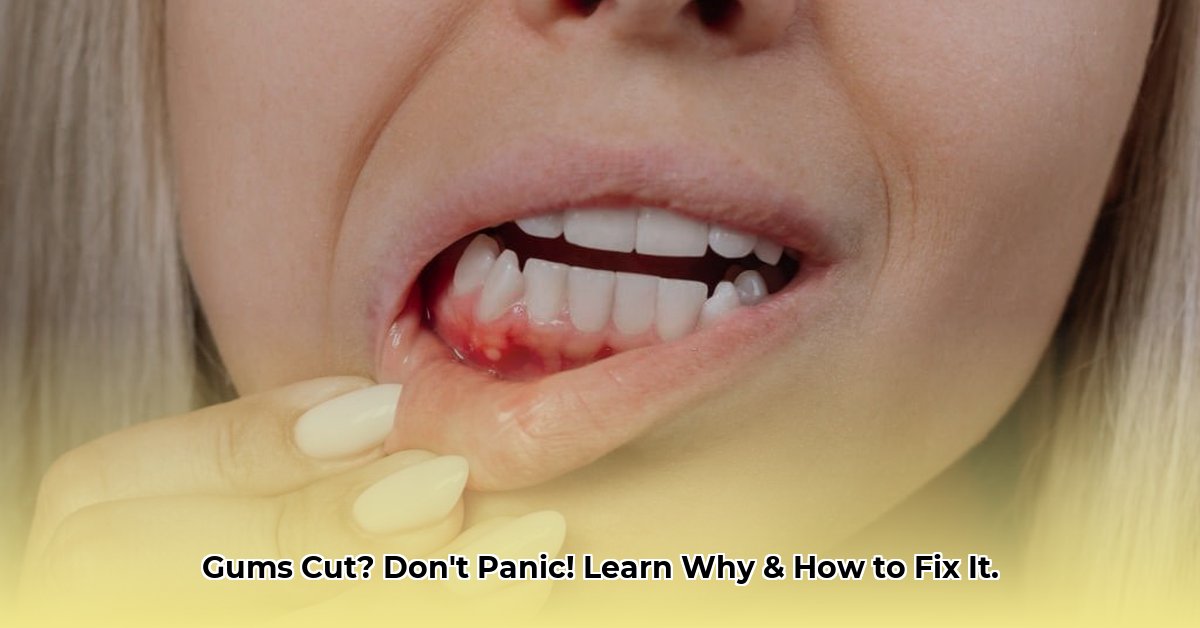A cut gum can be a painful surprise, whether from enthusiastic flossing, a rogue tortilla chip, or an unexpected fall. While most gum injuries heal quickly with simple care, knowing what to do—and when to seek professional help—can make all the difference. This guide provides a comprehensive approach to treating a cut gum, from immediate first aid to preventive measures.
Understanding Gum Injuries
Minor gum injuries, like a small cut from flossing or biting your cheek, are common and typically heal quickly. Deeper cuts, punctures, or burns require more attention. In rare cases, trauma can even tear gum tissue, potentially involving a tooth. Understanding your injury type is the first step toward recovery.
Treating a Cut Gum: A Step-by-Step Guide
Here’s a practical guide for treating a cut gum:
-
Clean Your Hands and Rinse Your Mouth: Wash your hands thoroughly with soap and water before touching the area. Gently rinse your mouth with cool water to remove debris.
-
Control the Bleeding: Apply gentle pressure to the cut using a clean cloth or gauze for 5-10 minutes. Resist the urge to peek, as this can disrupt clotting.
-
Soothe with Salt Water: Rinse your mouth several times a day with a warm saltwater solution (1/2 teaspoon salt in 8 ounces of water). Salt water acts as a natural disinfectant and may help reduce inflammation.
-
Apply a Cold Compress: Gently apply a cold compress to the outside of your cheek to reduce swelling and discomfort. Ice chips or a popsicle can also be soothing. Avoid applying ice directly to the gum tissue.
-
Eat Soft Foods: Stick to a diet of soft, easy-to-chew foods like yogurt, soup, and mashed potatoes. Avoid spicy, acidic, or hot foods that can irritate the cut.
-
Avoid Touching the Wound: Resist the urge to poke or prod the cut, as this can introduce bacteria and delay healing.
-
Manage Pain: Over-the-counter pain relievers like ibuprofen or acetaminophen can help manage discomfort. Follow package instructions and consult a doctor or pharmacist if you have any questions.
When to Seek Professional Help
While most cuts heal on their own, certain situations warrant professional attention:
| Symptom | Action |
|---|---|
| Bleeding that doesn’t stop after 15 minutes | Seek medical attention immediately. |
| Signs of infection (increased pain, swelling, redness, pus, fever) | See a dentist or doctor promptly. |
| Deep or wide cut | Consult a dentist or doctor. Stitches may be needed. |
| Difficulty swallowing or breathing | Seek immediate medical attention. |
| Loose teeth | See a dentist immediately. |
| Slow healing (no improvement after a few days) | Consult a dentist or doctor. |
Preventing Future Gum Injuries
Protecting your gums is easier than dealing with a cut. Here are some preventive measures:
- Gentle Brushing: Brush with a soft-bristled toothbrush using gentle circular motions. Aggressive brushing can damage gums.
- Careful Flossing: Gently guide floss between teeth, avoiding snapping.
- Sports Protection: Wear a mouthguard during contact sports.
- Regular Dental Checkups: Regular visits help identify and address potential issues early.
- Dietary Habits: Avoid excessively hard or sharp foods that can injure gums. Cut food into smaller pieces.
- Mindful Chewing: Pay attention while chewing to avoid accidentally biting your cheek or gums.
- Proper Use of Oral Appliances: Ensure proper fit and maintenance of dentures, retainers, or other oral appliances.
- Addressing Underlying Conditions: Discuss any medical conditions or medications that might affect gum health with your doctor or dentist.
Causes of Cut Gums
A variety of factors can cause cuts in your gums:
| Category | Examples |
|---|---|
| Sharp Foods | Hard pretzels, ice, popcorn kernels, tortilla chips, hard candies, crusty bread, bones |
| Aggressive Oral Hygiene | Brushing too hard, snapping floss, using a hard-bristled toothbrush |
| Trauma | Falls, sports injuries, impacts to the mouth, accidental bites (cheek, tongue), orofacial piercings |
| Dental Procedures | Slip of a dental instrument (rare) |
| Oral Appliances | Ill-fitting dentures, retainers, or braces rubbing against gums |
| Sharp Objects | Toothpicks, pencils, forks |
| Medical Conditions | Certain medical conditions can make gums more susceptible to injury. Consult your doctor for more guidance. |
Healing Time
Minor gum cuts typically heal within 3-7 days. Deeper cuts or lacerations may take 1-2 weeks or longer. Factors influencing healing time include the severity of the injury, individual healing rates, overall health, and adherence to aftercare instructions.
Ongoing Research and Uncertainties
While this information reflects current best practices, research into gum health is ongoing. New treatments and understandings of gum tissue healing are constantly evolving. Some experts suggest varying approaches for specific injuries. It’s always best to consult with a dental professional for personalized advice. They can assess your unique situation and provide tailored recommendations.
Disclaimer: This information is for educational purposes only and does not constitute medical advice. Always consult with a qualified healthcare professional for any health concerns or before making any decisions related to your health or treatment.
- Bento Box Trays Streamline Restaurant Meal Presentation and Transport - December 13, 2025
- Plastic Bento Boxes Face Scrutiny Over Sustainability Impacts - December 11, 2025
- Bento Tray Revolutionizes Organized Meal Transport and Presentation - December 10, 2025










